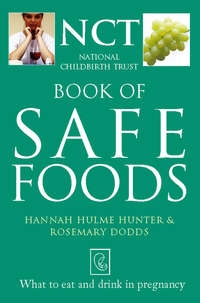Buch lesen: "Safe Food: What to eat and drink in pregnancy"
NCT Book of
Safe foods
Hannah Hulme Hunter and Rosemary Dodds

Copyright
Thorsons/National Childbirth Trust Publishing
Thorsons is an imprint of HarperCollinsPublishers Ltd. 1 London Bridge Street London SE1 9GF
First published by Thorsons and National Childbirth Trust 1998
Copyright © NCT Publishing 1998
Hannah Hulme Hunter and Rosemary Dodds assert the moral right to be identified as the authors of this work
A catalogue record for this book is available from the British Library
All rights reserved under International and Pan-American Copyright Conventions. By payment of the required fees, you have been granted the non-exclusive, non-transferable right to access and read the text of this e-book on-screen. No part of this text may be reproduced, transmitted, down-loaded, decompiled, reverse engineered, or stored in or introduced into any information storage and retrieval system, in any form or by any means, whether electronic or mechanical, now known or hereinafter invented, without the express written permission of HarperCollins e-books
HarperCollinsPublishers has made every reasonable effort to ensure that any picture content and written content in this ebook has been included or removed in accordance with the contractual and technological constraints in operation at the time of publication
Source ISBN: 9780722536070
Ebook Edition © AUGUST 2016 ISBN: 9780007399703
Version 2016-09-02
Contents
Cover
Title Page
Copyright
Introduction
1 What is ‘healthy eating’?
2 More about healthy eating
3 Safety first
4 ‘But I feel so awful’
5 Eating for two?
6 Healthy eating and lifestyle
7 Questions and (some) answers
8 After the birth
9 Breastfeeding
Index
About the authors
Other Titles in this Series
About the Publisher
Introduction
Meals should be times when we can sit back and enjoy the taste of good food. They should be times when our busy lives slow down a little, when we can chat with friends or family – or simply think our own thoughts. They should be times for rebuilding our energy, so we return to our work or our play with enthusiasm.
But eating is, of course, more than occasions. Eating a balanced diet is perhaps the single most important contribution we can make to our own wellbeing.
During pregnancy you are sharing your food and drink with your unborn baby. You are responsible for her growth and healthy development, as well as your own wellbeing. A good eating pattern during pregnancy: helps your body cope with the special demands of being pregnant; has a positive influence on the future health of your baby; builds up stores of energy and nutrients for times of need; and prepares your body for breastfeeding and nurturing your baby.
But it may not be easy during pregnancy to change your eating habits. Pregnancy is a very busy time for many women – working, looking after a home and family and fitting in clinic appointments. At the same time, you may not be feeling well – you may have pregnancy sickness or tiredness, and you may feel uncomfortably full and big. You may worry about putting on too much weight – or about not putting on enough. Many women are concerned about food safety – there seem to be so many rules and warnings about paté and eggs and soft cheeses. Sometimes it just seems easier to open another packet of chocolate biscuits! And so we decided to write this book.
The information in this book is based on sound scientific research. If the findings of the research are unclear, we say so. We offer you clear and unbiased information – but we do not make decisions for you. Each woman reading this will have unique needs and priorities, and you alone can make the decisions that suit your life. Only when risks are clear-cut do we firmly state a recommended course of action.
Whether you are planning to get pregnant, are newly pregnant or due to have your baby next month, we hope that this book will guide you, ease some of your anxieties – and support you when making food decisions during pregnancy. Above all, we hope this book will help make eating fun.
Hannah Hulme Hunter
Rosemary Dodds
September 1998
1 What is ‘healthy eating’?
Healthy eating is about choosing a balance of food, and feeling your best physically and mentally. Healthy eating is about real food – and enjoying eating.
In this chapter we describe the main food groups, explain why they are important and talk about the part that each group plays in a healthy and balanced diet.
Getting the balance right
Imagine an empty plate. Mentally divide the plate into three.
One-third will be full of energy foods: the starchy carbohydrates – pasta, potatoes, rice, yam, bread or cereals. Another third will be packed with fruit and vegetables. Divide the remaining third of the plate into three unequal sections, one a lot smaller than the other two. One of these sections is for protein foods, needed for growth and repair of our bodies – meat, fish, nuts, cooked beans and so on. The other section is for dairy products: the milk-based foods, rich in calcium and other minerals – fresh milk, yoghurt, cheese. The tiny bit in the middle is for fatty and sugary foods.
Now put some food onto your plate. Fill one whole third with rice, potatoes or pasta. Pack another third with lightly cooked vegetables. Put a small portion of fish or lean meat in one of the remaining bigger bits. In the other, put a tub of plain yoghurt. In the tiny bit in the middle, put a teaspoonful of honey to mix into the yoghurt. Pour yourself a glass or two of water. There – a balanced meal!
What about breakfast? Fill one-third of your plate with tinned grapefruit segments. Fill the next third with 2–3 slices of wholemeal toast. If you want to (and it doesn’t matter if you don’t for one meal), add an egg or a slice of lean ham. Place a glass of semi-skimmed milk in one of the smaller sections, and a pat of butter for the toast in the tiny one in the middle. Another balanced meal.
A quick working lunch? Fill one-third of your plate with a large roll of wholemeal bread. Pack the next third with some well-washed salad leaves, a sliced tomato and a crisp, green apple. In the small protein section put a hard-boiled egg or some slices of tasty Cheddar. (Don’t worry about the milk section; the cheese has taken care of that one this time.) Spread the bread roll with a small knob of low-fat spread, and wash down your meal with a carton of unsweetened orange juice.
Treats
Some women find it more helpful to imagine the plate filled with food for the whole day – or even for several days. So long as we get the balance right over about a week, that’s OK. This means that the bag of crisps we couldn’t resist in the cinema can fill up the tiny fatty foods section for several days – provided we don’t try to squeeze in extra dollops of cream as well! And the second helping of roast lamb enjoyed at the weekend can take care of our protein needs for a while, too.
But beware: many foods overlap the sections on the plate and need to be counted into both. Streaky bacon, for example, and ham with the fat still attached, will fill the small protein section – and overlap into the tiny fat section. (So no extra butter or spread for that meal.) Likewise, breakfast cereals are an excellent way of filling the carbohydrate section, but if they contain added sugar, that’s the sugar section overflowing as well. This is why it’s a good idea to choose low-fat and low-sugar foods – and leave the fat and sugar section free for the odd sweet or bag of crisps or whatever other treats we fancy.
Food choices from across the world
Wherever you come from, and whatever the origins of your choice of food, you can use these guidelines for a balanced diet. Simply decide in which group the foods you enjoy belong, and plan your meals around the same proportions described above.
In fact, we can all learn a lot about balanced eating from the food of other countries. Most Indian meals are based on plenty of rice or chapati, a vegetable curry and occasional fish or eggs. Traditional Italian meals generally involve lots of pasta, tasty tomato or milk-based sauces and perhaps a small quantity of meat. Much Chinese cooking centres on stir-fries of noodles, lightly cooked vegetables and seafood. Many traditional African meals involve plenty of starchy carbohydrate – yam, maybe, or pounded cassava – a spicy stew and green leafy vegetables.
Just one word of caution: if you also enjoy fatty foods such as chips, pies and crisps, keep a close eye on the total amount of fat in your diet.
Now let’s look more closely at the foods in each section of our plate.
What is a nutrient?
A nutrient is any substance that gives us nourishment and contributes to the smooth working of our bodies.
What are carbohydrates?
A third of our plate is packed with starchy carbohydrate foods. Carbohydrates should be the main food group that give us energy (calories). We all need energy foods, simply to keep our bodies working well. Some of us need more energy than others; a farmer, active all day in the open air, will need more energy than a secretary sitting at a desk. But even sitting and thinking uses up energy!
Caring for young children and running a home is particularly demanding work. An adequate intake of energy foods is very important, not only to give us the strength to keep going but to help us feel enthusiastic and happy doing so. During late pregnancy you need slightly more energy than at other times – but not much! It is certainly not true that you need to ‘eat for two’. We talk more about this in Chapter 5.
There are two types of carbohydrates – starches and sugars.
Starchy carbohydrates
Starchy foods include things like breakfast cereals, bread, chapati, nan, pitta, rice, pasta, noodles, potatoes, yam and plantain. These foods tend to be good and filling. The energy from starchy foods is slowly converted into sugars and gradually absorbed by our bodies. This means we feel satisfied for longer.
Starchy carbohydrate foods give us more than just energy. They are also important sources of other valuable nutrients – protein, vitamins, minerals and fibre. Starchy carbohydrate foods tend to be fairly cheap to buy.
Sugary carbohydrates
Sugary carbohydrate are found in foods such as sweet biscuits, cakes, jellies, puddings and sweets. These foods are not very filling and they can be expensive to buy. Sugary carbohydrates give us a quick boost of energy, but this energy is only short-lasting so we are likely to feel hungry again soon afterwards.
Sugary carbohydrates have very little nutritional value. This is why it is best not to eat too many sugary foods. It is far better to eat plenty of the starchy carbohydrate foods mentioned above – foods that give us more than just energy. We talk more about sugary foods a little later in this chapter.
Wholemeal foods
Generally, wholemeal or brown varieties of rice, pasta, cereals and bread tend to contain more vitamins, minerals and fibre than the refined or white kinds. For example, wholemeal bread contains half as much again of some of the important B group of vitamins than the same amount of white bread – and twice as much fibre. Wholemeal foods are very useful during pregnancy, when sometimes you may not feel like eating much, because even a relatively small quantity of a wholemeal food will still give you plenty of energy and other nutrients.
Wholemeal breakfast cereals are especially good value in nutritional terms. All breakfast cereals are good energy foods, and most are fortified. (Fortified means that extra vitamins or iron have been added.) Wholemeal cereals are also particularly rich in fibre. Add milk, maybe a few pieces of fresh or tinned fruit, and you have a balanced, get-up-and-go breakfast. Many people enjoy breakfast cereals at other times of the day, too.
How much starchy carbohydrate?
Along with fruit and vegetables, starchy carbohydrates make up the bulk of a balanced diet. Try to include some starchy foods in each meal – and aim for a total of six servings throughout the day. A ‘serving’ of starchy carbohydrates is equivalent to:
 2 large slices of bread
2 large slices of bread
 1 large bread roll, a pitta or a nan
1 large bread roll, a pitta or a nan
 2 Weetabix
2 Weetabix
 a large bowl of breakfast cereal ‘flakes’
a large bowl of breakfast cereal ‘flakes’
 a large bowl of porridge
a large bowl of porridge
 2 fist-sized potatoes or 2 pieces of yam
2 fist-sized potatoes or 2 pieces of yam
 a portion (about 6 tablespoons) of cooked pasta
a portion (about 6 tablespoons) of cooked pasta
 a portion (about 4 heaped tablespoons) of rice
a portion (about 4 heaped tablespoons) of rice
What are minerals?
Minerals are inorganic (not living) nutrients found naturally in many foods. Iron, calcium and zinc are examples of important minerals. Minerals are necessary for many body functions, including control of the balance of fluids in our bodies, as well as strong bones and teeth. As with vitamins, it is best to get minerals from our food, rather than take supplements.
What are vitamins?
Vitamins are special substances that our bodies need in order to function normally. Vitamins occur naturally in many foods – but no single food contains all vitamins except breast milk. Only one vitamin (vitamin D) can be made within our bodies – most have to be obtained from our food. Some vitamins can be stored in our bodies while others need to be eaten each day. We only need very small amounts of each vitamin. It is best to get vitamins from our food, rather than from supplements (except for folic acid). Too much vitamin A can be harmful during pregnancy.
Why are vegetables and fruit so important?
The next third of our plate is filled with vegetables and fruit. These foods are bursting with valuable nutrients including vitamins (especially vitamin C and folic acid) and minerals. Fruit and vegetables are our main source of antioxidants – special chemicals found naturally in foods that help protect our bodies against heart disease, cancer and the effects of pollution.
Fruit and vegetables are also a good source of fibre. Fibre (also found in cereals) is the part of our food that is not digested by our bodies. It passes through our digestive system and makes up the bulk of our faeces (bowel motion or poo). Fibre plays an important part in keeping our digestive systems running smoothly and preventing bowel diseases. If we do not have enough fibre in our diet, we may become constipated (have difficulty in passing a bowel motion).
Shopping for fruit and vegetables
If you can, buy fresh fruit and vegetables. Green leafy vegetables are good sources of folic acid. Yellow fruit such as mangoes and apricots, and citrus fruits such as oranges and grapefruits, are rich in vitamin C. But the main thing is to choose fruit and vegetables that you enjoy – and eat plenty!
Try to choose clean, undamaged items, store in a cool place and wash them well at home. Fruit and vegetables sold loose tend to be cheaper than trimmed and packaged items. Some market stall holders and green grocers sell their produce off at reduced prices at the end of the shopping day. Eat fruit and vegetables within a few days, while they are still fresh. And remember that over-cooking of vegetables will greatly reduce their vitamin content – and spoil their taste.
How much vegetables and fruit?
We cannot eat too much fruit and too many vegetables! We should all aim to eat five servings each day. A serving of fruit and vegetables is equivalent to:
 a piece of fruit – one apple, a single banana, a large slice of melon and so on
a piece of fruit – one apple, a single banana, a large slice of melon and so on
 12 chunks of tinned pineapple
12 chunks of tinned pineapple
 a small glass of unsweetened fruit juice
a small glass of unsweetened fruit juice
 a large bowl of salad
a large bowl of salad
 a large tomato
a large tomato
 3 tablespoons of peas
3 tablespoons of peas
 2 tablespoons of carrots or cabbage
2 tablespoons of carrots or cabbage
 a handful of raisins
a handful of raisins
 vegetable curry or vegetable stir-fry (counts as two servings if eaten as a main meal)
vegetable curry or vegetable stir-fry (counts as two servings if eaten as a main meal)
What about protein?
Protein foods fit into one of the smaller sections of our plate. This may surprise some people. The traditional approach to English meal planning tended to over-emphasise our need for protein – especially for meat protein. Nutritionists now know that we do not need as much protein as previously thought.
But protein is still a very important part of our diet. We need it to repair and maintain the basic building blocks of our bodies – our cells. We also need it to grow new cells; in particular, we need protein while pregnant to grow our babies. We need protein, too, to grow new blood cells and to produce antibodies (the special cells that help our bodies fight infection). Meat protein, in particular, is rich in valuable minerals such as iron and zinc. We talk more about these nutrients in Chapter 2.
Protein comes from two food sources – animal and vegetable. Whatever the source, the basic component of protein is the amino acid. There are many different amino acids. Our bodies can make some, but most need to be taken in our diet. The balance of amino acids in animal protein (in meat, milk and eggs) is similar to the balance required by our bodies. The balance of amino acids in vegetable protein (in nuts and lentils, for example) varies from food to food. This is why people who do not eat meat or drink milk need to eat a wide range of vegetable protein in order to get a good balance of amino acids.
Pregnancy increases the need for protein – but only by a small amount. A balanced diet including 2–3 servings of protein – vegetable, meat or a mixture of both – will easily take care of the extra bit required during pregnancy.
Animal protein
Animal sources of protein include all kinds of meat and fish. Turkey, chicken and fish tend to contain less saturated fat than red meat. (Saturated fat is the most harmful type of fat.) So, if you eat red meat (such as beef, lamb and pork), try to choose lean cuts – remember, you don’t need much!
Oily fish, such as mackerel, tuna and sardines (fresh or tinned), are particularly recommended as sources of protein – because they also give us essential fatty acids. We explain more about fatty acids later in this chapter.
Vegetable protein
Vegetable sources of protein include:
 nuts and seeds
nuts and seeds
 peanut butter (peanuts contain as much protein as most cheeses and twice as much as eggs – but see the note about peanut allergy at the end of Chapter 7)
peanut butter (peanuts contain as much protein as most cheeses and twice as much as eggs – but see the note about peanut allergy at the end of Chapter 7)
 meat substitutes, tofu (made from soya beans) and Quorn (made from a fungus)
meat substitutes, tofu (made from soya beans) and Quorn (made from a fungus)
 pulses including lentils (such as masur dhal), baked beans, kidney beans, black-eyed beans, butter beans, borlotti beans, mung beans, broad beans and all kinds of peas.
pulses including lentils (such as masur dhal), baked beans, kidney beans, black-eyed beans, butter beans, borlotti beans, mung beans, broad beans and all kinds of peas.
A well-planned vegetarian diet is extremely healthy. Vegetable protein foods are rich in fibre as well as protein, and contain many vitamins and minerals. Avoiding meat and using vegetable protein foods can be a good way of reducing your intake of saturated fat, and increasing your intake of fibre.
The protein in vegetable protein foods is less concentrated than the protein in animal protein foods. Servings tend to be larger. If you do not eat meat or drink milk, it is a good idea to include a serving of vegetable protein at each meal. Some other important nutrients are less concentrated in vegetable protein. Choose vegetable protein foods rich in iron, zinc, calcium and vitamin B12 (more about all of these nutrients in Chapter 2).
Die kostenlose Leseprobe ist beendet.











